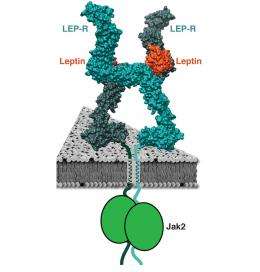Target for obesity drugs comes into focus

(Medical Xpress)—Researchers at the University of Michigan have determined how the hormone leptin, an important regulator of metabolism and body weight, interacts with a key receptor in the brain.
Leptin is a hormone secreted by fat tissue that has been of interest for researchers in obesity and Type 2 diabetes since it was discovered in 1995. Like insulin, leptin is part of a regulatory network that controls intake and expenditure of energy in the body, and a lack of leptin or resistance to it has been linked to obesity in people.
Although there can be several complex reasons behind leptin resistance, in some cases the underlying cause is malfunction of the leptin receptor in the brain. An understanding of how leptin and its receptor interact could lead to new treatments for obesity and metabolic disorders, but the structure of this signaling complex has evaded researchers for years.
Georgios Skiniotis, a faculty member at the Life Sciences Institute and assistant professor in biological chemistry at the U-M Medical School, employed electron microscopy to obtain the first picture of the interaction between leptin and its receptor.
Skiniotis also traced similarities between the leptin receptor and other receptors of the same family, which may provide insight into new targets for treatment of other hormone-related diseases.
"It is exciting not only because it might help with developing new drugs," Skiniotis said. "We now better understand the design and mechanisms of signaling through this class of receptors, which brings us to a whole new set of intriguing questions."
In the paper "Ligand-Induced Architecture of the Leptin Receptor Signaling Complex," published electronically ahead of print on Oct. 11 in Molecular Cell, Skiniotis and his co-authors explain how the receptor is formed by two hinged legs that can swivel until they encounter leptin, which binds to the legs and makes them rigid.
Once the two legs of a receptor become rigid by binding to leptin, they signal to an enzyme called the Janus kinase. A number of drugs have been studied for treatments related to the Janus kinases; inhibiting it may lead to improvement of conditions like rheumatoid arthritis, psoriasis and metabolic disorders that are linked to inflammation.
Alan Saltiel, director of the Life Sciences Institute and a widely cited researcher who works on diabetes, obesity and metabolic disorders, sees a range of possibilities in the work of Skiniotis.
"This study may help solve an important issue we've been struggling with for some time," he said. "Since leptin is a master regulator of appetite, understanding why resistance to its effects develops in obesity has been a major obstacle to discovering new drugs for obesity and diabetes. Developing a clear picture of how leptin can bind to its receptor may be the first step in overcoming leptin resistance."















